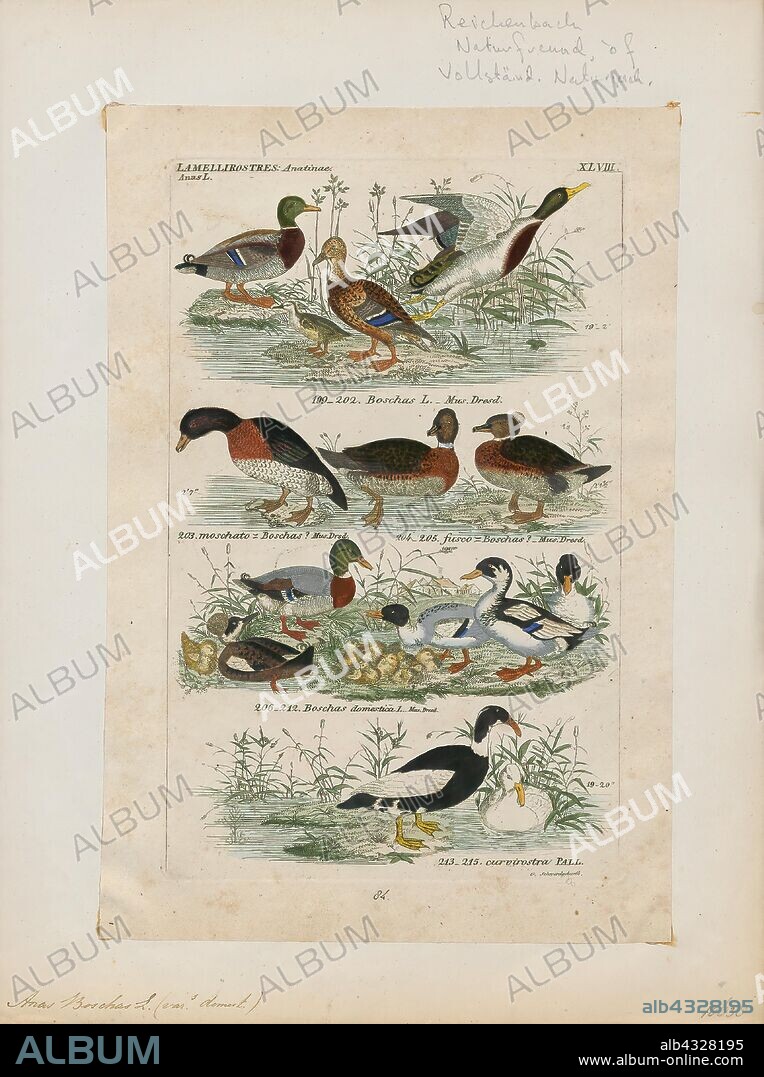alb4328195
Anas boschas, Print, The mallard (Anas platyrhynchos) is a dabbling duck that breeds throughout the temperate and subtropical Americas, Eurasia, and North Africa and has been introduced to New Zealand, Australia, Peru, Brazil, Uruguay, Argentina, Chile, Colombia, the Falkland Islands, and South Africa. This duck belongs to the subfamily Anatinae of the waterfowl family Anatidae. The male birds (drakes) have a glossy green head and are grey on their wings and belly, while the females (hens or ducks) have mainly brown-speckled plumage. Both sexes have an area of white-bordered black or iridescent blue feathers called a speculum on their wings; males especially tend to have blue speculum feathers. The mallard is 50–65 cm (20–26 in) long, of which the body makes up around two-thirds the length. The wingspan is 81–98 cm (32–39 in) and the bill is 4.4 to 6.1 cm (1.7 to 2.4 in) long. It is often slightly heavier than most other dabbling ducks, weighing 0.72–1.58 kg (1.6–3.5 lb). Mallards live in wetlands, eat water plants and small animals, and are social animals preferring to congregate in groups or flocks of varying sizes. This species is the main ancestor of most breeds of domesticated ducks., 1845-1863.

|
Add to another lightbox |
|
Add to another lightbox |



Buy this image.
Select the use:

Caption:
Anas boschas, Print, The mallard (Anas platyrhynchos) is a dabbling duck that breeds throughout the temperate and subtropical Americas, Eurasia, and North Africa and has been introduced to New Zealand, Australia, Peru, Brazil, Uruguay, Argentina, Chile, Colombia, the Falkland Islands, and South Africa. This duck belongs to the subfamily Anatinae of the waterfowl family Anatidae. The male birds (drakes) have a glossy green head and are grey on their wings and belly, while the females (hens or ducks) have mainly brown-speckled plumage. Both sexes have an area of white-bordered black or iridescent blue feathers called a speculum on their wings; males especially tend to have blue speculum feathers. The mallard is 50–65 cm (20–26 in) long, of which the body makes up around two-thirds the length. The wingspan is 81–98 cm (32–39 in) and the bill is 4.4 to 6.1 cm (1.7 to 2.4 in) long. It is often slightly heavier than most other dabbling ducks, weighing 0.72–1.58 kg (1.6–3.5 lb). Mallards live in wetlands, eat water plants and small animals, and are social animals preferring to congregate in groups or flocks of varying sizes. This species is the main ancestor of most breeds of domesticated ducks., 1845-1863
Credit:
Album / quintlox
Releases:
Model: No - Property: No
Rights questions?
Rights questions?
Image size:
3428 x 4592 px | 45.0 MB
Print size:
29.0 x 38.9 cm | 11.4 x 15.3 in (300 dpi)
Keywords:
1.6–3.5 LB • 1.7 • 1845-1863 • 2.4 • 20–26 • 32–39 • 4.4 • 50–65 CM • 6.1 CM • 81–98 CM • ABDOMEN • ANAS BOSCHAS • ANAS PLATYRHYNCHOS • AREA • ARGENTINA • ARGENTINE • AUSTRALIA • BELLY • BILL (INVOICE) • BILL OF SALE • BILL • BLUE SPECULUM FEATHERS • BODY MAKES UP • BRASIL • BRAZIL • BREEDS • CHILE • COLOMBIA • COMMERCE: BILL • CONGREGATE • DABBLING DUCK • DABBLING DUCKS • DOMESTICATED DUCKS • DRAKES • DUCK BELONGS • DUCKS • EAT WATER PLANTS • EURASIA • FALKLAND ISLANDS • FEMALES • FLOCKS • GLOSSY GREEN HEAD • GREY • GROUPS • HENS • IRIDESCENT BLUE FEATHERS • LENGTH • LONG • MAIN ANCESTOR • MAINLY BROWN-SPECKLED PLUMAGE • MALE BIRDS • MALES • MALLARD • MALLARDS LIVE • MAN MEN • MEN • MUJER • NEW ZEALAND • NORTH AFRICA • NORTH OF AFRICA • PERU • PRINT • RACES • SALTMARSH • SEXES • SLIGHTLY HEAVIER • SMALL ANIMALS • SOCIAL ANIMALS PREFERRING • SOUTH AFRICA • SOUTH OF AFRICA • SPECIES • SPECULUM • STOCK DUCK • STOMACH • SUBFAMILY ANATINAE • SUBTROPICAL AMERICAS • TEMPERATE • TEND • TWO-THIRDS • URUGUAY • VARYING SIZES • WATERFOWL FAMILY ANATIDAE • WEIGHING 0.72–1.58 KG • WETLANDS • WHITE-BORDERED BLACK • WINGS • WINGSPAN • WOMAN'S • WOMAN • WOMEN'S • WOMEN • WOMENS • ZEALAND
 Pinterest
Pinterest Twitter
Twitter Facebook
Facebook Copy link
Copy link Email
Email
